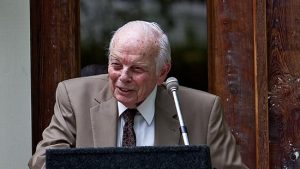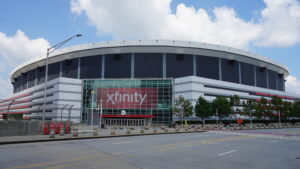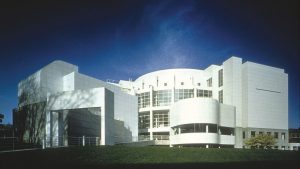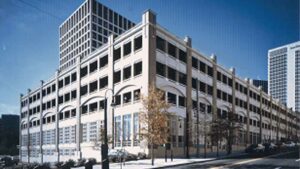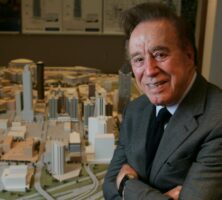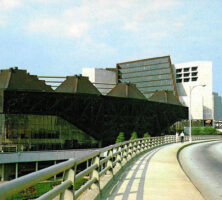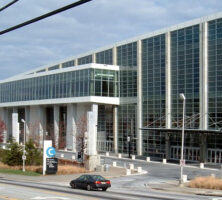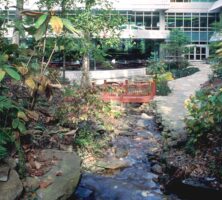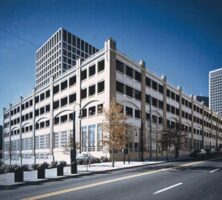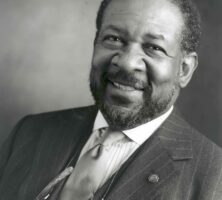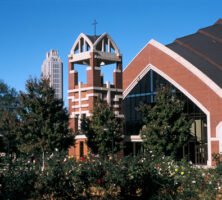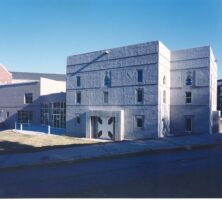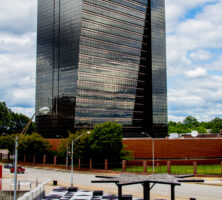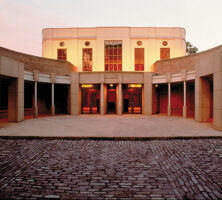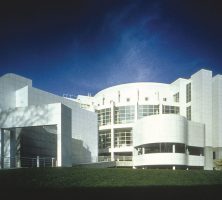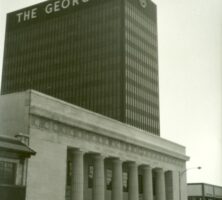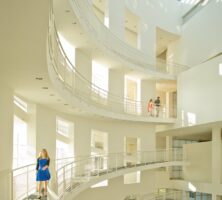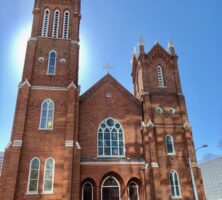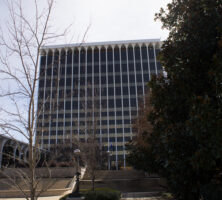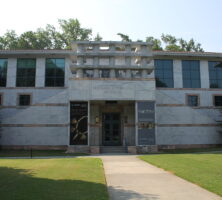The New Georgia Encyclopedia is supported by funding from A More Perfect Union, a special initiative of the National Endowment for the Humanities.
As part of the top 10 percent of naval aviators, Cecil Alexander volunteered for the marines and became a dive bomber pilot during World War II. The future Atlanta architect flew a total of sixty missions and was twice awarded the Distinguished Flying Cross.
Courtesy of Cecil Alexander
The New Georgia Encyclopedia does not hold the copyright for this media resource and can neither grant nor deny permission to republish or reproduce the image online or in print. All requests for permission to publish or reproduce the resource must be submitted to the rights holder.
A prominent Atlanta architect and principal of the FABRAP architectural firm before his retirement, Cecil Alexander was a leader in the movement to desegregate Atlanta's public housing and businesses. He is pictured in 2008.
Reprinted by permission of Stephen H. Moore (http://www.shmoore.com/)
The New Georgia Encyclopedia does not hold the copyright for this media resource and can neither grant nor deny permission to republish or reproduce the image online or in print. All requests for permission to publish or reproduce the resource must be submitted to the rights holder.
The BellSouth Telecommunications Building, located at 675 West Peachtree Street in Atlanta, was built in 1980 by the Atlanta-based firm FABRAP, in conjunction with Skidmore Owings and Merrill of New York. It served as headquarters for both Southern Bell and BellSouth. In 2006 BellSouth was absorbed by AT&T, and today the building is part of the AT&T Midtown Center.
Courtesy of AT&T
The New Georgia Encyclopedia does not hold the copyright for this media resource and can neither grant nor deny permission to republish or reproduce the image online or in print. All requests for permission to publish or reproduce the resource must be submitted to the rights holder.
Coca-Cola's headquarters in Atlanta, designed by the architectural firm FABRAP, house the corporate offices as well as the offices for the Coca-Cola Foundation.
Photograph by David A. Pike
The New Georgia Encyclopedia does not hold the copyright for this media resource and can neither grant nor deny permission to republish or reproduce the image online or in print. All requests for permission to publish or reproduce the resource must be submitted to the rights holder.
The Atlanta-Fulton County Stadium hosts the opening night of the World Series in October 1995. The stadium, jointly designed by the architecture firms FABRAP and Heery and Heery, was completed in 1965 and attracted two professional teams, the Atlanta Braves and the Atlanta Falcons, to the city.
Courtesy of Atlanta Journal-Constitution.
The New Georgia Encyclopedia does not hold the copyright for this media resource and can neither grant nor deny permission to republish or reproduce the image online or in print. All requests for permission to publish or reproduce the resource must be submitted to the Atlanta Journal-Constitution.
The architect Cecil Alexander, a founding partner of the firm FABRAP, and his second wife, Helen, pictured at their home in Atlanta in 2007.
Reprinted by permission of Stephen H. Moore (http://www.shmoore.com/)
The New Georgia Encyclopedia does not hold the copyright for this media resource and can neither grant nor deny permission to republish or reproduce the image online or in print. All requests for permission to publish or reproduce the resource must be submitted to the rights holder.
The Hyatt Regency Hotel in Atlanta, designed by John Portman, was completed in 1967. The structure features a twenty-two-story lobby and served as a model for other atrium hotels built in the 1970s and after.
Courtesy of Hyatt Press Photo Library
The New Georgia Encyclopedia does not hold the copyright for this media resource and can neither grant nor deny permission to republish or reproduce the image online or in print. All requests for permission to publish or reproduce the resource must be submitted to the rights holder.
John Portman, pictured in 2006, is a graduate of the architecture school at Georgia Tech and founder of the Atlanta firm Portman and Associates. Portman designed numerous buildings in the city, including the Peachtree Center Office Building, Westin Peachtree Plaza Hotel, and Atlanta Marriott Marquis.
Courtesy of Atlanta Journal-Constitution.
The New Georgia Encyclopedia does not hold the copyright for this media resource and can neither grant nor deny permission to republish or reproduce the image online or in print. All requests for permission to publish or reproduce the resource must be submitted to the Atlanta Journal-Constitution.
The New Georgia Encyclopedia does not hold the copyright for this media resource and can neither grant nor deny permission to republish or reproduce the image online or in print. All requests for permission to publish or reproduce the resource must be submitted to the rights holder.
The Promenade Two tower, built in Midtown Atlanta in 1990, was designed by the architectural firm Thompson, Ventulett, Stainback, and Associates. A steel spire tops the thirty-eight-story building, which is covered in rose-colored glass.
Photograph by Mary Ann Sullivan
The New Georgia Encyclopedia does not hold the copyright for this media resource and can neither grant nor deny permission to republish or reproduce the image online or in print. All requests for permission to publish or reproduce the resource must be submitted to the rights holder.
The Omni Coliseum, an arena completed in 1972, was the first major project for the Atlanta architectural firm Thompson, Ventulett, Stainback, and Associates. The arena held 16,500 spectators and was home to the Atlanta Hawks basketball team, as well as the site for numerous other sporting events and concerts.
Postcard from Scenic Card Company, Bessemer, Alabama. Photograph by J. H. Robinson
The New Georgia Encyclopedia does not hold the copyright for this media resource and can neither grant nor deny permission to republish or reproduce the image online or in print. All requests for permission to publish or reproduce the resource must be submitted to the rights holder.
The Georgia World Congress Center, viewed from the south, was built in Atlanta in 1976 by the architectural firm Thompson, Ventulett, Stainback, and Associates. By 2002 the center had expanded to include more than 1 million square feet.
Photograph by Mary Ann Sullivan
The New Georgia Encyclopedia does not hold the copyright for this media resource and can neither grant nor deny permission to republish or reproduce the image online or in print. All requests for permission to publish or reproduce the resource must be submitted to the rights holder.
The UPS Foundation headquarters are located in Atlanta at the UPS corporate office building, designed by the architectural firm Thompson, Ventulett, Stainback, and Associates. The foundation, which was established in 1951, provides grant money to organizations working to combat hunger and illiteracy, and also encourages volunteerism among UPS employees.
Courtesy of UPS
The New Georgia Encyclopedia does not hold the copyright for this media resource and can neither grant nor deny permission to republish or reproduce the image online or in print. All requests for permission to publish or reproduce the resource must be submitted to the rights holder.
Designed jointly by the architectural firms Stanley, Love-Stanley, and Thompson, Ventulett, and Stainback (TVS), the United Way of Metropolitan Atlanta parking garage received an Atlanta Urban Design Commission award in 1996.
Courtesy of Stanley, Love-Stanley, P.C.
The New Georgia Encyclopedia does not hold the copyright for this media resource and can neither grant nor deny permission to republish or reproduce the image online or in print. All requests for permission to publish or reproduce the resource must be submitted to the rights holder.
William J. "Bill" Stanley, a native of Atlanta, was the first African American to graduate from Georgia Tech with a degree in architecture. In 1978 he and his wife, Ivenue Love-Stanley, established the architectural firm Stanley, Love-Stanley in Atlanta, where he handles marketing and design.
Courtesy of Stanley, Love-Stanley, P.C.
The New Georgia Encyclopedia does not hold the copyright for this media resource and can neither grant nor deny permission to republish or reproduce the image online or in print. All requests for permission to publish or reproduce the resource must be submitted to the rights holder.
Ivenue Love-Stanley, a native of Mississippi, was the first African American woman to receive a degree in architecture from Georgia Tech. She is the cofounder, with her husband, Bill Stanley, of the Atlanta architectural firm Stanley, Love-Stanley, for which she serves as business manager and principal in charge of production.
Courtesy of Stanley, Love-Stanley, P.C.
The New Georgia Encyclopedia does not hold the copyright for this media resource and can neither grant nor deny permission to republish or reproduce the image online or in print. All requests for permission to publish or reproduce the resource must be submitted to the rights holder.
Ebenezer Baptist Church in Atlanta is currently housed in the Horizon Sanctuary, which seats 2,000 people and is situated across the street from the historic church building, today known as the Heritage Sanctuary. The Horizon Sanctuary was desiged by the Atlanta firm Stanley, Love-Stanley.
Courtesy of Georgia Department of Economic Development.
The New Georgia Encyclopedia does not hold the copyright for this media resource and can neither grant nor deny permission to republish or reproduce the image online or in print. Requests for permission to publish or reproduce the resource may need to be submitted to the Georgia Department of Economic Development.
The Lyke House Catholic Student Center at the Atlanta University Center was built in 1999 by the architectural firm Stanley, Love-Stanley. The center includes a chapel (pictured), as well as a student center and priest's rectory.
Courtesy of Stanley, Love-Stanley, P.C.
The New Georgia Encyclopedia does not hold the copyright for this media resource and can neither grant nor deny permission to republish or reproduce the image online or in print. All requests for permission to publish or reproduce the resource must be submitted to the rights holder.
The Georgia Dome in Atlanta was designed by architect George T. Heery's firm in collaboration with Rosser Fabrap International (formerly FABRAP). Completed in 1992 and demolished in 2017, the stadium was home to the Atlanta Falcons football team and also served as a venue for numerous other events.
Image from Michael Barera
The New Georgia Encyclopedia does not hold the copyright for this media resource and can neither grant nor deny permission to republish or reproduce the image online or in print. All requests for permission to publish or reproduce the resource must be submitted to the rights holder.
The Georgia Power Building in downtown Atlanta, designed by Heery Architects and Engineers, houses the headquarters for both the Georgia Power Company and the Georgia Power Foundation. In 2004 the Georgia Power Foundation awarded $5 million in grants to organizations primarily in the state of Georgia.
Image from Counse
The New Georgia Encyclopedia does not hold the copyright for this media resource and can neither grant nor deny permission to republish or reproduce the image online or in print. All requests for permission to publish or reproduce the resource must be submitted to the rights holder.
The Atlanta History Museum, located on the campus of the Atlanta History Center, is one of the Southeast's largest history museums. The 30,000-square-foot facility, designed by architect George T. Heery, opened in 1993 and houses four permanent exhibitions, as well as two galleries for traveling exhibitions.
Courtesy of Atlanta History Center.
The New Georgia Encyclopedia does not hold the copyright for this media resource and can neither grant nor deny permission to republish or reproduce the image online or in print. Requests for permission to publish or reproduce the resource should be submitted to the Atlanta History Center.
The High Museum of Art, located on Peachtree Street in Midtown Atlanta, houses a permanent collection of more than 11,000 pieces, including nineteenth- and twentieth-century American collections, folk art, and African art. Its current building, designed in 1983 by Richard Meier, has received awards and honors for its architectural excellence.
Courtesy of High Museum of Art
The New Georgia Encyclopedia does not hold the copyright for this media resource and can neither grant nor deny permission to republish or reproduce the image online or in print. All requests for permission to publish or reproduce the resource must be submitted to the rights holder.
The Georgia Railroad Bank Building, known today as the Wells Fargo Building, was erected in 1967 on Broad Street in Augusta to serve as headquarters for the First Railroad and Banking Company of Georgia. The building was designed by architect Robert McCreary.
Courtesy of Augusta Richmond County Historical Society, Reese Library Loose Photographs Collection, Broad Street Series.
The New Georgia Encyclopedia does not hold the copyright for this media resource and can neither grant nor deny permission to republish or reproduce the image online or in print. All requests for permission to publish or reproduce the resource must be submitted to the rights holder.
Designed by Richard Meier in the modernist style, the High Museum of Art in Atlanta was completed in 1983. In 2005 an addition to the museum, designed by architect Renzo Piano, opened to the public.
Courtesy of Explore Georgia, Photograph by Ralph Daniel.
The New Georgia Encyclopedia does not hold the copyright for this media resource and can neither grant nor deny permission to republish or reproduce the image online or in print. Requests for permission to publish or reproduce the resource may need to be submitted to Explore Georgia.
A "Save the Fox" poster from 1976 advertises "An Evening at the Fox" fund-raising event held by Delta Zeta sorority. During the 1970s, the theater was threatened with demolition, but efforts by Atlanta historic preservation groups prevented its destruction.
Courtesy of Fox Theatre. Copyright Delta Zeta Sorority
The New Georgia Encyclopedia does not hold the copyright for this media resource and can neither grant nor deny permission to republish or reproduce the image online or in print. All requests for permission to publish or reproduce the resource must be submitted to the rights holder.
Atlanta's Shrine of the Immaculate Conception, built in 1873-80, helped to establish William H. Parkins as one of Georgia's leading architects. More than a century later, in 1982-84, the building was restored by architect Henry Howard Smith, the son of renowned Atlanta architect Francis Palmer Smith, after the church was damaged by fire.
Image from Warren LeMay
The New Georgia Encyclopedia does not hold the copyright for this media resource and can neither grant nor deny permission to republish or reproduce the image online or in print. All requests for permission to publish or reproduce the resource must be submitted to the rights holder.
The Muscogee County Courthouse in Columbus was constructed in the early 1970s, after the Columbus and Muscogee governments merged to form a consolidated government. Designed by Edward W. Neal, the building is an example of the New Formalist style of modern architecture.
Courtesy of Don Bowman
The New Georgia Encyclopedia does not hold the copyright for this media resource and can neither grant nor deny permission to republish or reproduce the image online or in print. All requests for permission to publish or reproduce the resource must be submitted to the rights holder.
The architecture building at the Georgia Institute of Technology in Atlanta, completed in 1979, is an example of the Brutalist style of modern architecture. It was designed by architect Cooper Carry.
Photograph by Aria Ritz Finkelstein
The New Georgia Encyclopedia does not hold the copyright for this media resource and can neither grant nor deny permission to republish or reproduce the image online or in print. All requests for permission to publish or reproduce the resource must be submitted to the rights holder.
The Michael C. Carlos Museum at Emory University in Atlanta, designed by notable architect Michael Graves, offers numerous lectures, workshops, and performances as part of its educational program. Around 20,000 Georgia children visit the museum each year, and many more participate in Art Odyssey, the museum's outreach program.
Image from Gary Todd
The New Georgia Encyclopedia does not hold the copyright for this media resource and can neither grant nor deny permission to republish or reproduce the image online or in print. All requests for permission to publish or reproduce the resource must be submitted to the rights holder.
The New Georgia Encyclopedia does not hold the copyright for this media resource and can neither grant nor deny permission to republish or reproduce the image online or in print. All requests for permission to publish or reproduce the resource must be submitted to the rights holder.
